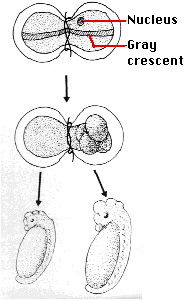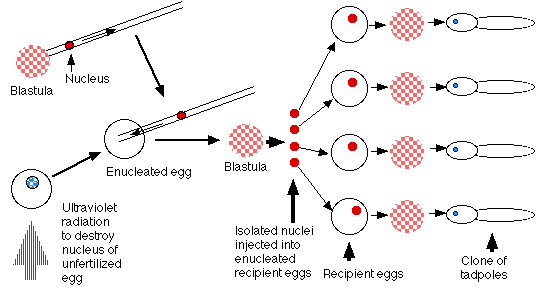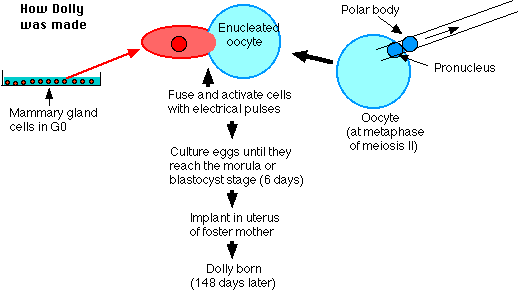"Clearly, someone will eventually clone a mammal, even a human. But I predict that when this occurs, the nuclei used will come from a very early embryo, probably an 8-cell or 16-cell morula. But that morula will represent the genetic potential of a human being never before seen. All that will have been accomplished is a modest expansion of nature's ability to produce identical twins, triplets, and so on. The probability of ever being able to use nuclei from adults, whose traits we know, seems very remote."
But in February 1997, a research team at the Roslin Institute in Edinburgh, Scotland, headed by Dr. I. Wilmut, reported (in the 27 February 1997 issue of Nature) that they had succeeded in producing a healthy lamb, named Dolly, from the nucleus of a cell taken from an adult sheep.
Why has this achievement created such a stir (and put my prediction on very shaky ground)?

After all, all the cells in an adult are
So each cell in the adult would be expected to carry the complete diploid complement of genes of the organism.
Back in the 20s, the German experimental embryologist Hans Spemann showed that even after 5 divisions of the fertilized egg, the nuclei retained the potential to program the complete development of an adult. Using strands of baby hair, he tied loops around fertilized amphibian (newt) eggs so that they were constricted into two halves with
Spemann's results suggest, then, that cloning should be possible. Genetically-identical nuclei should be able to produce genetically-identical individuals. And, of course, that is what occurs in human identical twins, triplets, etc. They are "miniclones".
Since Spemann's time, the development of micromanipulators has made it possible to remove nuclei from cells. To test the developmental potential of these nuclei, they can then be injected into "enucleated" eggs; that is, eggs whose own nucleus has been removed or destroyed. Using this technique (called somatic-cell nuclear transfer or SCNT), it was found that the nucleus of any of the thousands of cells of the frog blastula is able to guide perfectly normal development when transplanted into a frog egg lacking its own nucleus.

Furthermore, when a transplanted nucleus has programmed the formation of a new blastula, the cells of the new blastula can then serve as the source of identical nuclei to use to form a clone of genetically-identical tadpoles.
When nuclei from adult frog cells are transplanted into enucleated eggs, the results have not been so successful. Many of the resulting embryos are abnormal and stop developing. Despite years of effort, no adult frogs have been produced by nuclei transplanted from adult frog cells. (However, some other animals have been successfully cloned using nuclei from adult cells [Link]).
No one knows for certain. But what is known is that during development, the DNA of differentiated cells does change — not in its sequence — but in its ability to be expressed (transcribed). The DNA becomes chemically altered. As many as 8% of the cytosines (C) in an organism's DNA become methylated. Genes containing methylated DNA are inactive. So it appears that although every cell in the adult organism contains the entire genome, many of the genes can no longer be expressed.
What Dr. Wilmut's group has done is find a way to unlock the full potential of gene expression in the nuclei of cells taken from an adult mammal. They do not know the biochemical basis of their achievement, but this is how they did it.
The result: one ewe gave birth (148 days later) to Dolly.

What made Dolly different?
The Wilmut group also used the same technique to produce healthy lambs using cells from lamb embryos (9 days after fertilization) and lamb fetuses (26 days after fertilization). But in these experiments, there was no way to know the phenotype of the nuclear donor because it had not yet been born. So, too, the recent cloning of monkeys from embryo nuclei represents simply an expansion of nature's ability to produce identical twins, etc. whose traits we will not know until they are born and grow up. But the nucleus that made Dolly came from an adult animal whose phenotypic traits were there to be seen.
How do we know that Dolly is not the progeny of an unsuspected mating of the foster mother?| An update. Some scientists have argued that Dolly could have come from a fetal cell that contaminated the mammary gland tissue culture (the cell donor was pregnant at the time). However, two groups have reported (in the 23 July 1998 issue of Nature) that DNA fingerprinting proves that Dolly has a genome identical to the cultured cells and the Finn Dorset ewe that supplied them. |
Besides years of hard work, we do not know. Perhaps:
| What about Dolly's telomeres? It turns out that her telomeres are only 80% as long as those in a normal one-year-old sheep. Link to a discussion of the significance of telomere shortening in the life of the cell. |
| What about Dolly's mitochondria? Although her nuclear genome came from the Finn Dorset ewe, her mitochondria came from cytoplasm of the Scottish Blackface ewe. Mitochondria carry their own genome and so with respect to the genes in mitochondrial DNA, she is not a clone of the Finn Dorset parent. |
Since the arrival of Dolly, somatic-cell nuclear transfer (SCNT) has been used to produce seemingly-healthy cows, mice, rats, goats, pigs, rabbits, cats, a mule ("Idaho Gem"), a horse, and a dog.
Don't count on it. Great interest is being shown in using somatic-cell nuclear transfer to create embryonic stem cells that could be used to replace missing or defective cells in the body of the nuclear donor.
| Link to a discussion. |
But the same blastocysts could, in theory, instead be implanted in a uterus to produce a fetus that was a clone of the cell donor.
But keep in mind that humans are not sheep, cows, or mice.
Despite these concerns, a group of South Korean scientists has succeeded in producing cloned human blastocysts by somatic cell nuclear transfer (SCNT) using nuclei from adult human skin cells and placing these in eggs from unrelated women. They used the blastocysts to create embryonic stem cells [Link], and made no attempt to implant them to create a baby.
| Welcome&Next Search |